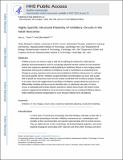Highly Specific Structural Plasticity of Inhibitory Circuits in the Adult Neocortex
Author(s)
Chen, Jerry L.; Nedivi, Elly
DownloadNedivi_Highly specific.pdf (371.2Kb)
OPEN_ACCESS_POLICY
Open Access Policy
Creative Commons Attribution-Noncommercial-Share Alike
Terms of use
Metadata
Show full item recordAbstract
Inhibitory neurons are known to play a vital role in defining the window for critical period plasticity during development, and it is increasingly apparent that they continue to exert powerful control over experience-dependent cortical plasticity in adulthood. Recent in vivo imaging studies demonstrate that long-term plasticity of inhibitory circuits is manifested at an anatomical level. Changes in sensory experience drive structural remodeling in inhibitory interneurons in a cell-type and circuit-specific manner. Inhibitory synapse formation and elimination can occur with a great deal of spatial and temporal precision and are locally coordinated with excitatory synaptic changes on the same neuron. We suggest that the specificity of inhibitory synapse dynamics may serve to differentially modulate activity across the dendritic arbor, to selectively tune parts of a local circuit, or potentially discriminate between activities in distinct local circuits. We further review evidence suggesting that inhibitory circuit structural changes instruct excitatory/inhibitory balance while enabling functional reorganization to occur through Hebbian forms of plasticity.
Date issued
2013-03Department
Massachusetts Institute of Technology. Department of Biology; Massachusetts Institute of Technology. Department of Brain and Cognitive Sciences; Picower Institute for Learning and MemoryJournal
The Neuroscientist
Publisher
Sage Publications
Citation
Chen, J. L., and E. Nedivi. “Highly Specific Structural Plasticity of Inhibitory Circuits in the Adult Neocortex.” The Neuroscientist 19, no. 4 (August 1, 2013): 384–93.
Version: Author's final manuscript
ISSN
1073-8584
1089-4098